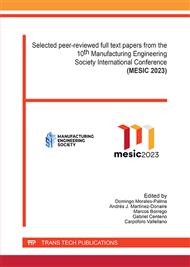[1]
Airbus. Airbus Global Market Forecast 2021-2040. 2021.
Google Scholar
[2]
Chryssolouris G, Papakostas N, Mavrikios D. A perspective on manufacturing strategy: Produce more with less. CIRP J Manuf Sci Technol 2008;1.
DOI: 10.1016/j.cirpj.2008.06.008
Google Scholar
[3]
Stavropoulos P, Chantzis D, Doukas C, Papacharalampopoulos A, Chryssolouris G. Monitoring and control of manufacturing processes: A review. Procedia CIRP, vol. 8, 2013.
DOI: 10.1016/j.procir.2013.06.127
Google Scholar
[4]
Nath C. Integrated tool condition monitoring systems and their applications: A comprehensive review. vol. 48, 2020.
DOI: 10.1016/j.promfg.2020.05.123
Google Scholar
[5]
Li X, Liu X, Yue C, Liang SY, Wang L. Systematic review on tool breakage monitoring techniques in machining operations. Int J Mach Tools Manuf 2022;176.
DOI: 10.1016/j.ijmachtools.2022.103882
Google Scholar
[6]
Serin G, Sener B, Ozbayoglu AM, Unver HO. Review of tool condition monitoring in machining and opportunities for deep learning. International Journal of Advanced Manufacturing Technology 2020;109.
DOI: 10.1007/s00170-020-05449-w
Google Scholar
[7]
Teti R, Jemielniak K, O'Donnell G, Dornfeld D. Advanced monitoring of machining operations. CIRP Ann Manuf Technol 2010;59.
DOI: 10.1016/j.cirp.2010.05.010
Google Scholar
[8]
Coady J, Toal D, Newe T, Dooly G. Remote acoustic analysis for tool condition monitoring. Procedia Manuf, vol. 38, 2019.
DOI: 10.1016/j.promfg.2020.01.165
Google Scholar
[9]
Gomathi K, Balaji A. Tool condition monitoring of PCB milling machine based on vibration analysis. Mater Today Proc, vol. 45, 2021.
DOI: 10.1016/j.matpr.2020.12.778
Google Scholar
[10]
Balsamo V, Caggiano A, Jemielniak K, Kossakowska J, Nejman M, Teti R. Multi Sensor Signal Processing for Catastrophic Tool Failure Detection in Turning. Procedia CIRP, vol. 41, 2016.
DOI: 10.1016/j.procir.2016.01.010
Google Scholar
[11]
Guerra-Sancho A, Perez JF, Garrido MHM, Guisandez JLC, Alvarez JD. Countersink depth control in aeronautical structural components drilling processes by machining forces analysis. 2022 8th International Engineering, Sciences and Technology Conference (IESTEC), IEEE; 2022, p.715–22.
DOI: 10.1109/IESTEC54539.2022.00117
Google Scholar
[12]
Zhou L, Li J, Li F, Meng Q, Li J, Xu X. Energy consumption model and energy efficiency of machine tools: A comprehensive literature review. J Clean Prod 2016;112.
DOI: 10.1016/j.jclepro.2015.05.093
Google Scholar
[13]
Diaz N, Redelsheimer E, Dornfeld D. Energy consumption characterization and reduction strategies for milling machine tool use. Glocalized Solutions for Sustainability in Manufacturing - Proceedings of the 18th CIRP International Conference on Life Cycle Engineering, 2011.
DOI: 10.1007/978-3-642-19692-8_46
Google Scholar
[14]
Hu L, Zheng H, Shu L, Jia S, Cai W, Xu K. An investigation into the method of energy monitoring and reduction for machining systems. J Manuf Syst 2020;57.
DOI: 10.1016/j.jmsy.2020.10.012
Google Scholar
[15]
Domínguez-Monferrer C, Fernández-Pérez J, de Santos R, Miguélez MH, Cantero JL. CFRP drilling process control based on spindle power consumption from real production data in the aircraft industry. Procedia CIRP 2022;107:1533–8.
DOI: 10.1016/j.procir.2022.05.187
Google Scholar
[16]
Domínguez-Monferrer C, Fernández-Pérez J, de Santos R, Miguélez MH, Cantero JL. Machine learning approach in non-intrusive monitoring of tool wear evolution in massive CFRP automatic drilling processes in the aircraft industry. J Manuf Syst 2022;65:622–39.
DOI: 10.1016/j.jmsy.2022.10.018
Google Scholar
[17]
Chapter 2 Metallurgical failure analysis. Practical Machinery Management for Process Plants, vol. 2, 1999
DOI: 10.1016/S1874-6942(99)80004-2
Google Scholar



